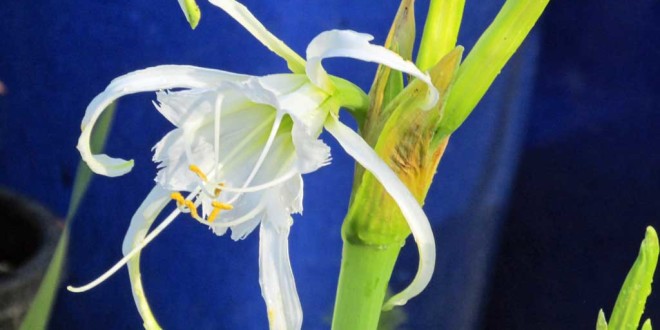Hymenocallis is a wonderful genus of bulbous amaryllis…native mostly to the US, Mexico, and Central America. Hymenocallis (spider lilies) are an easy-to-grow moisture-lover that are a reliable perennial wildflower in the garden. Spider lilies are a tough, low maintenance plant which makes it perfect for rain gardens.
In the wild many Hymenocallis (spider lilies) often grow in or near water or, in a seasonally flooded woodland. However, most hymenocallis perform just as well in an average garden soil. Hymenocallis produce unusual white, spider-like, nocturnally fragrant flowers that are large enough to see from quite a distance. Hymenocallis is definitely a “gotta have it” plant. try growing your spider lily next to dahlia, buddleia, sarracenia, sabatia, or hibiscus.
Note: The bulb is enormous! You need at least a 5 gallon container.
What is Spider Lily Poisoning? Spider lily refers to several plants in the Amaryllidaceae family with large dramatic flowers. Each of these plants contains a combination of natural alkaloids which can be toxic. The name spider lily is applied to several plants within the Amaryllidaceae family. These plants are classified in the either the crinum, hymenocallis, or lycoris genus. Although each variety is toxic, the alkaloids causing the toxicity can vary between groups. They should not be confused with the spider plant Chlorophytum comosum. Despite their similar names, the plants are not closely related and the spider plant, unlike the spider lily, is non-toxic. If your pet consumes any portion of a spider lily plant, you should contact your veterinarian right away for further instructions. Symptoms like muscle spasms and diarrhea can occur; a visit to the clinic is imperative with ingestion of the spider lily.
Read more at: https://www.vetary.com/dog/condition/spider-lily-poisoning
Border Planting:
Borders and divider flowerbeds define and separate areas of a garden. Planting a mass of spider lilies to line a walkway or decorate a fence is a landscaping option. If the background plants in a border flowerbed are taller than 2 feet, then spider lilies, which grow 1 to 2 feet tall, work well as accent plants in the front of the border bed. Conversely, you can plant spider lilies in the back of a border bed as background for short annual flowers. If you worry that the flowerbed will look bare in summer after foliage dies and before flowers emerge, plant summer-blooming perennials among the spider lily bulbs.
Companion Planting:
The companion plants chosen for spider lily affects the garden’s overall effect. Spider lilies are incredibly dramatic texture plants; so if you wish to achieve a dramatic flowerbed, choose similar flowers to plant among the spider lilies. Perhaps the best companion to achieve this dramatic effect is the similarly named spider flower (Cleome hasslerana), a fall-blooming annual that grows up to 6 feet tall and features short, stubby petals with long, spiky stamens. Spider flower can serve as a background plant for your spider lily. Another idea is to plant spider lily bulbs in a bed among spring-flowering bulbs so the spring-blooming bed receives color in fall. Spider lily also makes a striking addition when planted in a bed among other fall-blooming bulbs, such as colchicums (Colchicum spp.) and fall-flowering crocuses (Crocus spp.).
Details
Genus: Hymenocallis (hy-men-oh-KAL-is) (Info)
Species: speciosa (spee-see-OH-suh) (Info)
Category: Bulbs
Height:
12-18 in. (30-45 cm)
18-24 in. (45-60 cm)
24-36 in. (60-90 cm)
Spacing:
12-15 in. (30-38 cm)
15-18 in. (38-45 cm)
18-24 in. (45-60 cm)
Hardiness:
USDA Zone 10a: to -1.1 °C (30 °F)
USDA Zone 10b: to 1.7 °C (35 °F)
USDA Zone 11: above 4.5 °C (40 °F)
Sun Exposure: Sun to Partial Shade
Danger: All parts of plant are poisonous if ingested
Bloom Color: White/Near White
Bloom Time: Late Summer/Early Fall; Mid Fall; Late Fall/Early Winter
Foliage: Evergreen; Smooth-Textured
Other details:
Average Water Needs; Water regularly; do not overwater
Soil pH requirements:
6.1 to 6.5 (mildly acidic)
6.6 to 7.5 (neutral)
7.6 to 7.8 (mildly alkaline)
Patent Information: Non-patented
Propagation Methods: By dividing rhizomes, tubers, corms or bulbs (including offsets); From seed; sow indoors before last frost
Seed Collecting: Allow pods to dry on plant; break open to collect seeds
Read more: http://davesgarden.com/guides/pf/go/789/#ixzz3GnERzAtt








